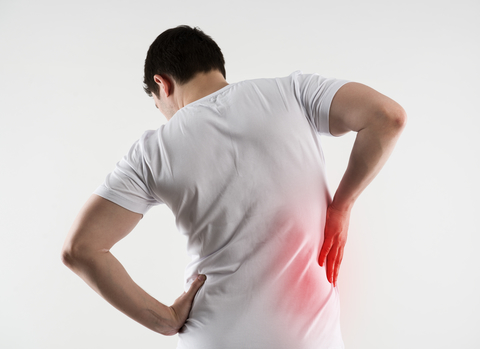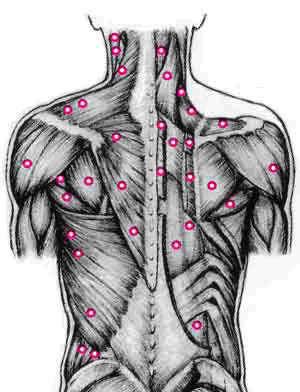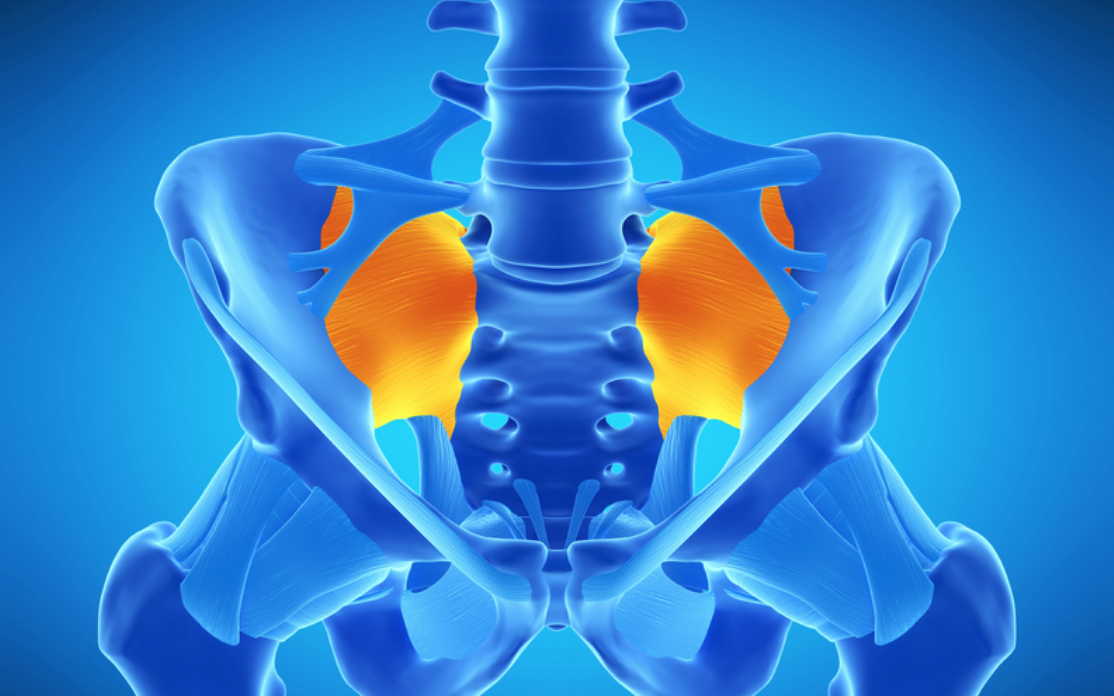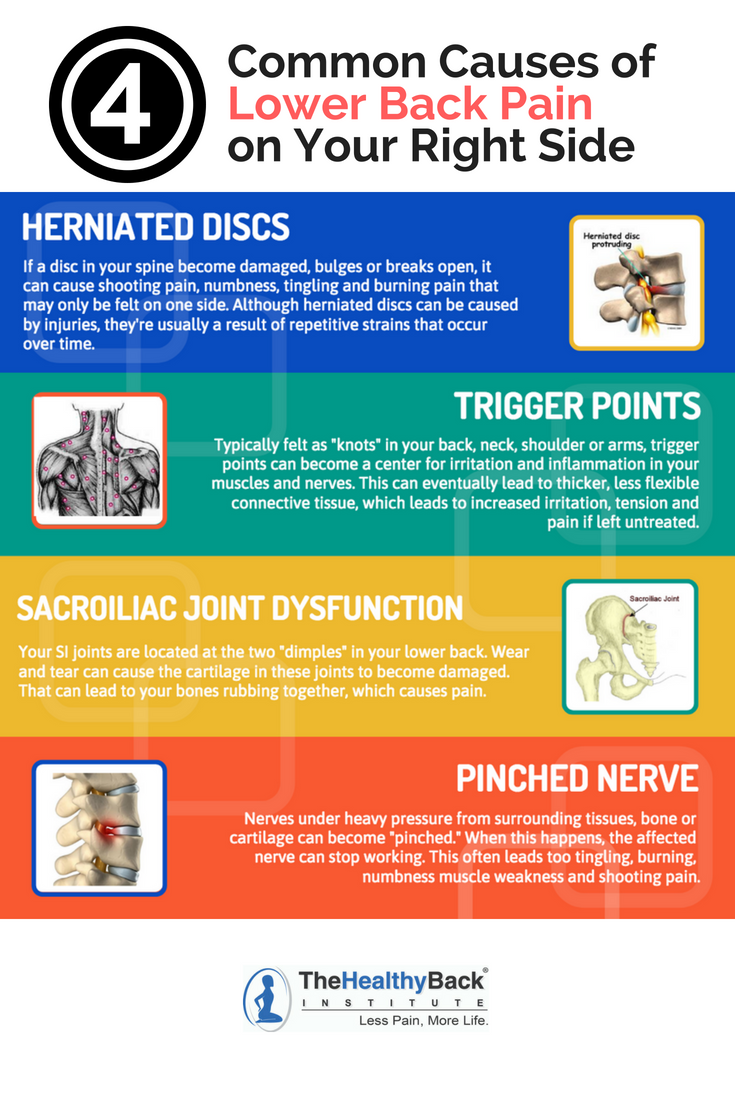
Medically reviewed by Dr. Brian Paris, D.C on Nov. 6, 2018.
Would it surprise you if I said you might have a neurological disorder? If you have lower back pain on your right side, you do.
In fact, back pain of any kind is the second most common neurological (or nervous system) disorder after headaches. And as of 2018, it’s one of the top reasons people visit the doctor.
It makes sense when you consider the unique structures that make up your back… including your spine.
It also gives us a clue why some people have back pain only on the right side…
In this article, I’ll explain the most common causes of back pain on the lower right side. I’ll also teach you some helpful prevention tips so you can avoid future recurrences as well as share the single most effective way to resolve all back pain issues.
Table of contents
[#1] What causes pain in the lower right back?
[#2] The 4 most common causes of right lower back pain
[#3] Other causes of lower back pain on the right side
[#4] How to prevent lower right side back pain
[#5] Fix lower back pain on the right side by correcting muscle imbalances
What causes lower back pain on the right side only?
To fully understand the cause of back pain, you must understand how the back works.
Take this definition from The National Institute of Neurological Disorders and Strokes (NINDS):
The back is an intricate structure of bones, muscles, and other tissues that form the posterior part of the body’s trunk, from the neck to the pelvis.
The centerpiece is the spinal column, which not only supports the upper body’s weight but houses and protects the spinal cord – the delicate nervous system structure that carries signals that control the body’s movements and convey its sensations…
In other words, your back is complicated. And your spinal cord is both fragile and super important.
Fortunately, your body is perfectly designed to protect this delicate structure.
More than 30 bones, called your vertebrae, are stacked on top of each other to form your spine.
Think of it as your spinal cord’s suit of armor.
Each of these bones has a hole so that when they are all stacked together, they create a channel for your spinal cord.
Your spinal cord descends from the base of your brain to just below your rib cage.
The spaces between the vertebrae have spongy discs that cushion your bones as you move. Think of them as “shock absorbers.”
Bands of tissue – your ligaments and tendons — hold your vertebrae in place and attach your muscles to your spinal column.
Most of the time, lower back pain on the right side is caused by years of misuse or overuse of the muscles, tendons and ligaments in your back. This leads to an imbalance in your body.
Over time, this places tremendous amounts of uneven pressure and wear and tear on your body… especially on your vertebrae, discs, spine and its supporting muscles, ligaments and tendons.
The end result is often pain, which you might feel across your lower back or in your upper back.
It may even radiate down your legs.
For many people, however, the pain is only felt in the right side of the lower back. If you are experience lower left back pain, then visit this page to read about possible treatments.
Let’s take a look at some of the possible common causes of lower right back pain.
Key takeaway: Muscles balances caused by years of misuse or overuse can lead to pain over time.
4 common causes of lower back pain on the right side
1. Herniated discs
Would you believe that one out of every three people have a herniated disc?
That’s a lot of people!
This occurs when your discs – the “shock absorbers” of your spine – become damaged, bulge or break open.
Sounds terrible, right? It definitely can be…
Symptoms of a herniated disc can vary dramatically, but is most commonly associated with sciatica, when the herniated or bulging disc presses on your sciatic nerve.
A herniated disc can lead to severe pain that travels down the back of your leg, numbness and tingling in your legs, and burning back pain that may be felt on only one side.
Injuries or a sudden awkward movement (like lifting a heavy object) can also cause a herniated disc.
But more often they’re caused by repetitive strains that occur slowly over a lifetime.
Sitting or standing with poor posture, inactivity, hunching over your computer for long hours… all of these can lead to varying degrees of muscle imbalances, where one muscle is used more often (and therefore grows stronger) than an opposing muscle (which becomes weakened).
This, in turn, leads to postural dysfunctions, in which your bones remain in an abnormal position, leading to uneven and excessive compression and torsion that causes discs to bulge or herniate.
Fortunately, there are a number of safe, natural treatments for herniated discs that don’t involve surgery or drugs.
To learn more about natural herniated disc treatments click right here.
2. Trigger points

Triggerpoints are typically felt as “knots” in your back (they can also occur in your neck, shoulders and arms).
If left untreated, they can become inflamed and irritated, causing chronic pain.
This ongoing inflammation leads to fibrosis, which thickens your connective tissues.
Thicker connective tissue is less flexible, leading to a vicious cycle of more irritation… more tension… and more pain as your body pulls on each trigger point.
Trigger points are common because they occur when an area of your body is injured or overworked.
And this doesn’t only refer to strains from physical work, but also from:
- lack of use
- muscle strain
- sedentary behavior
- a long commute
- too much time spent sitting
- nutritional deficiencies
- emotional stress
- lack of sleep
- and much, much more.
While you can do physical therapy, get massages, chiropractic care, or even a trigger point specialist to receive manual trigger point therapy, the success of the treatment depends on the skill level of the practitioner.
And well-trained trigger point therapists are VERY hard to come by, not to mention expensive!
3. Sacroiliac joint dysfunction

Your sacroiliac (SI) joints, the points where your spine meets your pelvis, are located at the two “dimples” in your lower back.
As you age, wear and tear on your SI joints’ cartilage can become damaged, allowing your bones to rub together, leading to pain.
Because your sacroiliac joints support the entire weight of your upper body when you stand, walk or perform any other upright activity, pain in this area can be debilitating.
If you talk to most mainstream health care professionals about pain in your SI joints, they’ll probably pull out their little pad and write you a prescription for a painkiller.
Or they’ll suggest taking over-the-counter pain medications like ibuprofen or an anti-inflammatory.
That’s a cop-out, in my opinion.
Here’s what I want you to understand about inflammation…
In any condition in which inflammation is present, most doctors completely overlook a patient’s diet.
And a healthy diet is one of the best ways to reduce inflammation naturally.
There are also natural supplements available that contain natural anti-inflammatories combined with proteolytic enzymes to give your body a powerful and proven one-two punch against inflammation and pain.
Additionally, you can perform daily SI joint exercises and stretches that can quickly relieve pain.
4. Pinched nerve

Another common cause of lower back pain on your right side is a pinched nerve.
If a nerve receives too much pressure from surrounding tissues, bone or cartilage, it can become “pinched” and unable to transmit electrical signals properly.
Eventually, when a nerve is pinched it may stop working entirely, which often leads to tingling, burning and shooting muscle pain along with feelings of numbness or muscle weakness.
Back pain on the right side is often associated with a pinched nerve due to inflammation and pressure on the nerve root as it exits your spine.
A herniated or bulging disc in your spine is another common reason that nerves get “pinched.”
If you’re suffering from a pinched nerve, check out our list of handy pinched nerve exercises.
Key takeaway: The 4 main causes of lower right side back pain are herniated discs, trigger points, sacroiliac joint dysfunction and pinched nerves.

Other causes of lower right side back pain
The four conditions I listed above cause most cases of back pain on the lower right side. But there are a few other medical issues that are worth investigating if it turns out your back pain isn’t a mechanical issue…
- kidney stones
- kidney infection
- gallbladder stone
- spondylolysis
- osteoporosis
- irritable bowel syndrome
- urinary tract infection (may include fever, chills and pain in the abdomen)
- gynecological disorder (in women, obviously)
- muscle strain
- spinal compression fracture
- appendicitis (Appendicitis symptoms include pain in the abdomen that may radiate to the back, along with fever, chills, nausea and vomiting. Note: Appendicitis is a medical emergency. If your back pain is accompanied by these symptoms, you should seek medical attention.)
Key takeaway: Although most back pain on the lower right side is caused by a mechanical issue, there are other conditions that can cause it, some of which require immediate medical attention.
Preventing lower back pain on the right side
Many cases of back pain that occurs on the lower right side (or anywhere in the back) can be prevented. This is particularly true if your lower right side back pain stems from one of the four main causes that I explained above.
Here are three easy things you can do to ward off back pain and problems:
Check your posture: Always keep an upright position while walking and sitting.
Lift with care: You’ve heard it 1,000 times… but it’s important. Always lift by bending at the knees while lifting heavy objects. Never from the waist!
Exercise regularly: Studies have shown time and time again that keeping active keeps all kinds of aches and pains away… not just back pain.
Key takeaway: To prevent right side back pain flare-ups, practice good posture, take care when lifting heavy objects and get regular exercise.
Resolve muscle imbalances for right side lower back pain relief
Like I mentioned earlier, everyday activities could be the cause of that nagging pain you’re feeling in the lower right side of your back.
Activities like digging in your yard… hunching over your computer… or being inactive… throw off the natural balance of your body.
One muscle is used more often (and therefore grows stronger) than an opposing muscle (which becomes weakened).
In other words, you get muscle imbalances.
That leads to postural dysfunctions, in which your bones stay in an abnormal position for too long.
And THAT can cause uneven and excessive compression (squeezing) and torsion (twisting) that causes problems with your back health.
Muscle Balance Therapy™ addresses both the discomfort of lower back pain on your right side and the root of the problem.
That is, what’s causing the pain in the first place.
Through strategic body assessments, you’ll be able to identify your individual muscle imbalances.
Once that’s done, you’ll be able to design a custom, targeted corrective program for your specific needs.
The system will also teach you the specific exercises that will help you strengthen muscles and help relieve pressure on any affected nerves.
Key takeaway: The Healthy Back Institute offers a custom program for eliminating the muscle imbalances that lead to all types of back pain.
5 key takeaways about lower back pain on the right side
Key takeaway #1: The wear and tear caused by everyday activities can lead to muscle imbalances, which is often the source of all back pain, including pain that’s only felt on the lower right side.
Key takeaway #2: The four most common causes of right side lower back pain — herniated disc, trigger points, sacroiliac joint dysfunction and pinched nerves — are all mechanical problems.
Key takeaway #3: Although less common, there are some non-mechanical issues that can cause lower back pain on the right side which may require medical intervention.
Key takeaway #4: You can prevent lower right side back pain by maintaining proper posture, being careful while lifting heavy objects and by getting regular exercise.
Key takeaway #5: Muscle Balance Therapy™, which is taught in the Lose the Back Pain® System, addresses and helps heal the muscle imbalances that lead to lower right side back pain.
Editor’s note: This article has been reviewed by a member of our medical advisory board. The content provided is for informational purposes only and should not be construed as medical advice. Please consult with your physician if you have any questions about your health.
Read more:
Lower Left Back Pain: Symptoms, Causes and Treatments
17 Back Muscles That Cause the Most Back Pain (and how to get relief!)



Hi I’ve have spent a fortune on my back over my years
I’m hoping this is the one for me
Jeff
My husband after a long hard working life of 78 years has increasingly painful back problems. His CT’ s show bone spurs, he’s had an outpatient surgery that solidified his sacroiliac joint stability. Kept smaller back problems ok througb massage, warm baths, ice packs. Other ideas: invert board in concert w/trigger. (Oh, bad left knee. Rt knee replaced)
HI Leslie,
Thank you for posting regarding your husband’s back issues. We believe education is key to dealing with pain and we would suggest as a good starting point that you get yourself a copy of our book the “7 Day Back Pain Cure”. The book discusses back pain issues and related pains, various treatment options you can consider, pain relief suggestions, action plans and other helpful information for when dealing with pain.
Do please read more details and information about the 7 Day Back Pain Cure book via the link below
https://losethebackpain.com/products/7-day-back-pain-cure-book
Our Best Wishes
Admin (The Healthy Back Institute)
Interesting blog, good information given about the effects of lower back pain right side and why one should avoid it. Was very helpful, thanks for sharing the blog with us.
Hi Jesse Cannone
Amazing blog, you share the good information about the effects of lower back pain right side. It is very helpful to us. Thanks for sharing !!!!!
Hello Jesse Cannone
Interesting blog, you share the right information about the effects of lower back pain right side.Thanks for sharing this amazing blog!!!!!